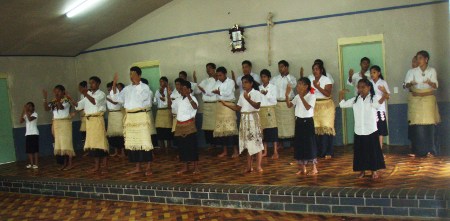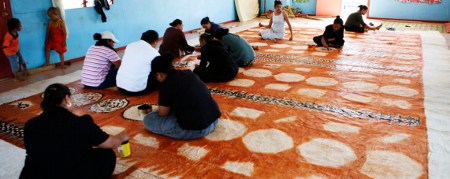Villages Of 'Eua Island Tonga
Villages of 'Eua Island Tonga are made up of the original 'Euan peoples, the peoples of Ata, and the peoples of the Nuias.
There are 14 villages on 'Eua Island, most of them run along the top of the island from 'Ohonua to Ha'atua.
Five of them are orignial villages and date back thousands of years these are 'Ohonua, Tufuvai, Pangai, and Houma and Ha'atua.
One village are the peoples of 'Ata who were moved to 'Eua in 1860 to protect them from the Peruvian slave traders. These people merged with the village called Ha'atua.
The other eight villages were settled by the people of Niuafo'ou in 1946 following a volcanic eruption on there home island.
Entering a village in ’Eua is like walking back in time. The villages do the things they have been doing for centuries. Making Tapa, weaving mats, cooking in the ground, gathering food from sea and land.

The Youth Of Tufuvai Village Preforming In The Fale Fakataha
FALE FAKATAHA
(meeting house)
Tongan villages have a meeting house (Fale fakataha) where meetings, dances, kava ceremonies and village gatherings take place.
The Fale fakataha is the focal point for the village community, the equivalent in western culture would be a town hall of sorts.

Women Painting Tapa Cloth In The Fale Ngaue
FALE NGAUE
(work house)
Villages in Tonga have a special work house ( Fale ngaue ) for the woman to make there crafts such as Tapa cloth, mat weaving and so on .
Although traditionally these crafts are made by the woman, the planting and growing of the plants needed for these crafts is up to the men of the village and a lot of careful pruning of excessive leaves and branches which may cause knots, that can damage the quality of the Tapa ( Ngatu ) is required.
The women dont weave and make crafts only for the practical reasons that the comfort and utility of woven and Tapa goods provide. They weave and make Tapa for the companionship it creates among women and of course the creative pleasure it gives the maker.
The fale ngaue is in itself a great place for the women to get together and communicate with each other, while producing crafts of quality, beauty and practicality, having fun and a good laugh in the process.
